![]()
GREETINGS
COUSINS
SEARCHING
GENEALOGY
CIVIL RECORDS
ITALIAN WORDS
ABRUZZO
SCANNO to NYC
BASILICATA
LANGUAGE
CULTURE
LITERATURE
MUSIC
FOOD
GIARDINO
SEMENTI
HERBAL REFS
COSE
![]()
Photos may be re-cycled with the author's permission.
![]()
DISCLAIMER: Please read - SAFETY PROCEDURES: Please read. Basic rule of thumb: Leaf teas usually DO NOT get boiled. Pour boiling water over the leaves, steep and strain. Root and bark teas usually DO get boiled.
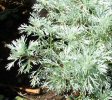 Artemisia Assenzio Artemisia Absinthum - Visit the forum "la Fée Verte".
Artemisia Assenzio Artemisia Absinthum - Visit the forum "la Fée Verte".
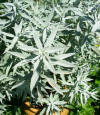 Artemisia Sage, Artemisia ludoviciana - Tea used as a blood purifier, cold remedy, liver tonic, & sometimes used to jumpstart a delayed menstrual cycle. Our plants muscled their way right through the strawberries.
Artemisia Sage, Artemisia ludoviciana - Tea used as a blood purifier, cold remedy, liver tonic, & sometimes used to jumpstart a delayed menstrual cycle. Our plants muscled their way right through the strawberries.
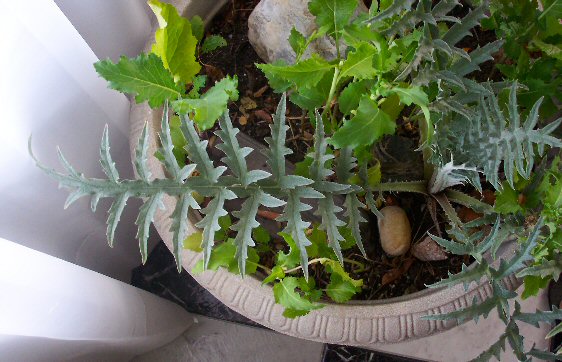 Artichoke Carciofo Cynara scolymus L. - Artichoke lowers cholesterol and blood-lipids, & protects and regenerates the liver. (Maros T et al. Wirkungen der Cynara scolymus-Extrakte auf die Regeneration der Rattenleber. Arzneimittelforschung 1966; 16: 127-9)
Artichoke Carciofo Cynara scolymus L. - Artichoke lowers cholesterol and blood-lipids, & protects and regenerates the liver. (Maros T et al. Wirkungen der Cynara scolymus-Extrakte auf die Regeneration der Rattenleber. Arzneimittelforschung 1966; 16: 127-9)
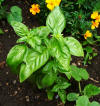 Basil Basilico Ocimum basilicum L. - Contains 6 compounds that lower blood pressure (fennel has 10 according to Dr. Duke). A symbol of eternal love. Can be hung near doorways to repel flies, although if you look closely at the photo...
Basil Basilico Ocimum basilicum L. - Contains 6 compounds that lower blood pressure (fennel has 10 according to Dr. Duke). A symbol of eternal love. Can be hung near doorways to repel flies, although if you look closely at the photo...
Bean Fagiolo Phaseolus vulgaris L. - Lowers blood glucose levels. Run a Pub Med search on ?diabetes and beans?, ?diabetes and guar gum?, ?diabetes and Plantago psyllium mucilage? (see also: Common Plantain)
Bergamot, Bee Balm, Monarda didyma L. - Attracts hoards of butterflies. Leaf tea used to relieve colic and gas.
 Blackberry Rovo Rubus fructicosus L. - Leaf tea used for diarrhea.
Blackberry Rovo Rubus fructicosus L. - Leaf tea used for diarrhea.
Bloodroot, Sanguinaria canadensis - Used topically on skin cancer (Dr. Weil). Was an ingredient in the former toothpaste "Viadent" as a study showed that it reduced plaque.
Borage Borragine Borago officinalis L. - Massage onto cold fingers, one of the herbs used for Raynaud's.
 Broccoli Brassica - High in beta-carotene & fiber - keeps you looking youthful. Helps lower blood pressure. These are Jo's lovely plants. I have better success with "rabe" (Italian leaf broccoli) in my garden.
Broccoli Brassica - High in beta-carotene & fiber - keeps you looking youthful. Helps lower blood pressure. These are Jo's lovely plants. I have better success with "rabe" (Italian leaf broccoli) in my garden.

 Burdock Bardana Arctium lappa - Once established, these plants are extremely difficult to remove due to the long tap root. The root tea used as a blood purifier is an ingredient in Essiac tea. Seeds, separated out of the burs, are poulticed on bruises. Burdock leaves and flowers are effective against gram-negative and gram-positive bacteria. (Cappelletti EM et al. External antirhuematic and antineuralgic herbal remedies in the traditional medicine of North-eastern Italy. J Ethnopharmacol 1982;6: 161-90)
Burdock Bardana Arctium lappa - Once established, these plants are extremely difficult to remove due to the long tap root. The root tea used as a blood purifier is an ingredient in Essiac tea. Seeds, separated out of the burs, are poulticed on bruises. Burdock leaves and flowers are effective against gram-negative and gram-positive bacteria. (Cappelletti EM et al. External antirhuematic and antineuralgic herbal remedies in the traditional medicine of North-eastern Italy. J Ethnopharmacol 1982;6: 161-90)

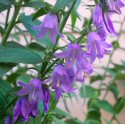 Bellflowers Campanula Campanula "In an old Calabrian tale, a maiden, uprooting a rampion in a field, discovers a staircase that leads to a palace far down in the depths of the earth."
Bellflowers Campanula Campanula "In an old Calabrian tale, a maiden, uprooting a rampion in a field, discovers a staircase that leads to a palace far down in the depths of the earth."
 Cardoon Cardo ("Wild Artichoke") The celery like stems are delicious. Cardoon seeds courtesy of Mimi Torchia Boothby who wrote a charming story about her family's recent trip to Italy with plenty of photos.
Cardoon Cardo ("Wild Artichoke") The celery like stems are delicious. Cardoon seeds courtesy of Mimi Torchia Boothby who wrote a charming story about her family's recent trip to Italy with plenty of photos.

 Chicory Cicoria Cichorium intybus L. - Includes radicchio... for salad and cooked greens. Roasted ground ?blue chicory root? brewed as a caffeine-free coffee substitute, made famous during the "Great Depression". (Note: Caffeine causes your adrenaline to rise, which prompts your liver to flood your body with sugar, thereby stimulating your pancreas to kick out insulin. Caffeine should be avoided by diabetics.) One study shows that chicory counteracted the hepatotoxic effects of high doses of acetaminophen. Is related to milk thistle, another Italian plant. See Milk Thistle - Cardo Mariano.
Chicory Cicoria Cichorium intybus L. - Includes radicchio... for salad and cooked greens. Roasted ground ?blue chicory root? brewed as a caffeine-free coffee substitute, made famous during the "Great Depression". (Note: Caffeine causes your adrenaline to rise, which prompts your liver to flood your body with sugar, thereby stimulating your pancreas to kick out insulin. Caffeine should be avoided by diabetics.) One study shows that chicory counteracted the hepatotoxic effects of high doses of acetaminophen. Is related to milk thistle, another Italian plant. See Milk Thistle - Cardo Mariano.
Chives, Onion, Garlic Cipolla, Porro Allium - We grew up eating (and admiring) Aunt Marie's chives and picking "wild" green onions in our fields. Leaves relieve head congestion. Ingested raw garlic is said to strip fat from blood vessel walls & the strong juice from sliced garlic is applied to ringworm.
Chokecherry Prunus virginiana L. - Found in the fields near our childhood home. Am checking on its proximity to an Italian cousin Ciliegio Prunus avium L. (Una ciliegia tira l'altra...) We used to eat these small deep purple berries right off the tree and spit out the pits. Pound whole ripe berries with pits in, spread on a platter and dry to make a nice tart fruit leather. Drying them thoroughly neutralizes the toxins.
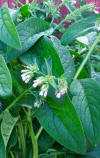 Comfrey Sinfito Symphytum officinale - The word "comfrey" alludes to the uniting of bones "con firma". Used topically (as a poultice) mends bones, strains, and sprains. The allantoin in comfrey promotes new cell growth. Comfrey is toxic to the liver and kidneys if ingested.
Comfrey Sinfito Symphytum officinale - The word "comfrey" alludes to the uniting of bones "con firma". Used topically (as a poultice) mends bones, strains, and sprains. The allantoin in comfrey promotes new cell growth. Comfrey is toxic to the liver and kidneys if ingested.
Common Mallow Malva Neglecta Wallr. - Common mallow, known as "Cheeses" (the seed pod resembles a tied round of cheese), is edible and the leaves are said to be great soup thickeners. Slightly mucilaginous, it's soothing to an upset stomach and sore throat. I'm certain this plant was used experimentally in India as a form of male birth control and was discontinued due to "side effects".
 Common Plantain Piantaggine maggiore Plantago major (Lance leaved - Piantaggine minore / Lingua di cane Plantago lanceolata L.) - Takes away the itch from a mosquito bite and the swelling from a bee sting. Have used it with other plants to alleviate poison ivy rash. After one application, the rash stopped burning and began to heal. (Jewelweed also works) Common Plantain is found in lawns near houses and buildings. Take one leaf and fold it in quarters. Crush by rubbing between the fingers or heat with a lighter. I've seen one Grandmother chew it and spit the juice on a sting, but my children prefer the "lighter" method. Perhaps it's the magic of the flame that intrigues them. No contraindications for common plantain. Safe for everyone, it's even edible.
Common Plantain Piantaggine maggiore Plantago major (Lance leaved - Piantaggine minore / Lingua di cane Plantago lanceolata L.) - Takes away the itch from a mosquito bite and the swelling from a bee sting. Have used it with other plants to alleviate poison ivy rash. After one application, the rash stopped burning and began to heal. (Jewelweed also works) Common Plantain is found in lawns near houses and buildings. Take one leaf and fold it in quarters. Crush by rubbing between the fingers or heat with a lighter. I've seen one Grandmother chew it and spit the juice on a sting, but my children prefer the "lighter" method. Perhaps it's the magic of the flame that intrigues them. No contraindications for common plantain. Safe for everyone, it's even edible.

 Currants Ribes Ribes rubrum L. - High in vitamin C, also contains several anti-asthma compounds (Duke).
Currants Ribes Ribes rubrum L. - High in vitamin C, also contains several anti-asthma compounds (Duke).
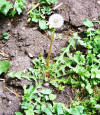 Dandelion Tarassaco, Soffione, Dente di Leone Taraxacum officinalis - Ricette. Young tender leaves eaten as Spring greens, wine made from the flowers. Purported to be a liver tonic by some although others dispute this. A detoxifier. Steam the leaves gently with rabe, garlic, a touch of red pepper. Drizzle with lemon & olive oil.
Dandelion Tarassaco, Soffione, Dente di Leone Taraxacum officinalis - Ricette. Young tender leaves eaten as Spring greens, wine made from the flowers. Purported to be a liver tonic by some although others dispute this. A detoxifier. Steam the leaves gently with rabe, garlic, a touch of red pepper. Drizzle with lemon & olive oil.
 Elderberry Sambuco Sambucus nigra L. - Tea used to treat colds and flu. Some toxicity warnings - research further if you intend to use this.
Elderberry Sambuco Sambucus nigra L. - Tea used to treat colds and flu. Some toxicity warnings - research further if you intend to use this.
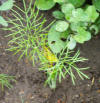 Fennel Finocchio Foeniculum dulce, Foeniculum vulgare Mill - Tea used for heartburn. Fennel (like other "anise-y" plants) is packed with natural estrogen. No doubt this is why the word for fennel has another connotation in Italian slang.
Fennel Finocchio Foeniculum dulce, Foeniculum vulgare Mill - Tea used for heartburn. Fennel (like other "anise-y" plants) is packed with natural estrogen. No doubt this is why the word for fennel has another connotation in Italian slang.
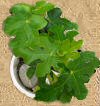 Fig Fico Ficus carica L. - Figs, particularly the greenery contain an enzyme, that breaks down proteins. Care should be taken to protect exposed skin when trimming a fig tree. Join the Fig Forum for tips on growing figs. Read about the Di Paola family in Ethnic Figs in America
Fig Fico Ficus carica L. - Figs, particularly the greenery contain an enzyme, that breaks down proteins. Care should be taken to protect exposed skin when trimming a fig tree. Join the Fig Forum for tips on growing figs. Read about the Di Paola family in Ethnic Figs in America
Ginger Zenzero Zingiber officinale Roscoe - Commonly used as a tea for colds.
Grape Hyacinth - Tufted Cipollini Muscari comosum - The bulb is a tasty appetizer, usually harvested while the first few leaves are young, before budding.
 Grapes Vite Uve Vitis vinifera L. - Use grape leaf tea for stomachaches, diarrhea, and thrush. Leaves can be poulticed for headaches, fever, and rheumatism. Grape leaves are very tasty. Stuff with rice, pignoli or almonds, finely chopped lamb, roll and steam or bake in broth.
Grapes Vite Uve Vitis vinifera L. - Use grape leaf tea for stomachaches, diarrhea, and thrush. Leaves can be poulticed for headaches, fever, and rheumatism. Grape leaves are very tasty. Stuff with rice, pignoli or almonds, finely chopped lamb, roll and steam or bake in broth.
Juniper Ginepro Juniperus communis L. - Juniper berries (used to make gin) used as a flavoring in meat dishes and said to lower blood sugar. Use sparingly - juniper irritates the kidneys and is a powerful diuretic.
 Lambsquarters Farinello comune Chenopodium album - Leaves and seeds are edible - raw or cooked. Somewhere (?) I read that Napoleon kept his army going on the seeds of this plant when other food was scarce.
Lambsquarters Farinello comune Chenopodium album - Leaves and seeds are edible - raw or cooked. Somewhere (?) I read that Napoleon kept his army going on the seeds of this plant when other food was scarce.
Milk Thistle Cardo Mariano Silybum marianum (L.)Gaertn. - A nice Italian plant. Milk thistle (white streaks on the leaves) is widely & successfully used for liver problems; from amanita poisoning to cirrhosis.
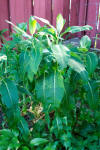
 Milkweed Aclepia Asclepias syriaca - Milky sap is used on warts. Cook and eat the round globed flower buds, packed with easily assimilated calcium. References claim this plant is toxic and the mature leaves should be avoided. The flower buds and young leaves (under 1 inch in length) are an old time food of indigenous people who lived long healthy lives. Good enough for me.
Milkweed Aclepia Asclepias syriaca - Milky sap is used on warts. Cook and eat the round globed flower buds, packed with easily assimilated calcium. References claim this plant is toxic and the mature leaves should be avoided. The flower buds and young leaves (under 1 inch in length) are an old time food of indigenous people who lived long healthy lives. Good enough for me.
Mustards Wild Senape Sinapis alba L. - An excellent addition to soup. According to Dr. Duke they are the best source of tyrosine which (along with iodine from kelp) might increase levels of the thyroid hormone thyroxine.
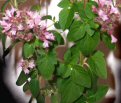 Oregano Origano Origanum vulgare L. (Maggiorana Origanum majorana L.) - Besides flavoring our favorite sauce/gravy is used for sinusitis and is antioxidant.
Oregano Origano Origanum vulgare L. (Maggiorana Origanum majorana L.) - Besides flavoring our favorite sauce/gravy is used for sinusitis and is antioxidant.
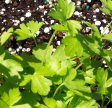 Parsley (Italian) Prezzemolo Petroselinium neapolitanum - Leaves are chewed to aid in digestion and freshen breath. Poulticed leaves ease inflammation from insect bites.
Parsley (Italian) Prezzemolo Petroselinium neapolitanum - Leaves are chewed to aid in digestion and freshen breath. Poulticed leaves ease inflammation from insect bites.
 Peppermint Chocolate Mint Menta Mentha piperata - Fresh mint is a healthy source of vitamin C. Formerly used to expel worms.
Peppermint Chocolate Mint Menta Mentha piperata - Fresh mint is a healthy source of vitamin C. Formerly used to expel worms.
![]() Pineapple Weed Camomilla? Matricaria matricarioides - Used as a calming tea like Chamomile. The fresh pineapple scent is released by slightly crushing the flower heads or foliage. Commonly found in waste areas; near the road, in the cracks of a driveway, thriving where other less hardy plants dare not go.
Pineapple Weed Camomilla? Matricaria matricarioides - Used as a calming tea like Chamomile. The fresh pineapple scent is released by slightly crushing the flower heads or foliage. Commonly found in waste areas; near the road, in the cracks of a driveway, thriving where other less hardy plants dare not go.

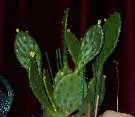 Prickly Pear
Fico d'India Opuntia - Pads & fruit are edible. Gummy flesh of the pads slow the release of sugar in the bloodstream, a great food for diabetics. I learned to eat the fruit while in Mexico after being chided by a youngster to stop trying to chew the seeds - an attempt that proved impossible. Later, I learned I didn't need to travel so far to try Opuntia fragilis. Opuntia in Wisconsin.
Prickly Pear
Fico d'India Opuntia - Pads & fruit are edible. Gummy flesh of the pads slow the release of sugar in the bloodstream, a great food for diabetics. I learned to eat the fruit while in Mexico after being chided by a youngster to stop trying to chew the seeds - an attempt that proved impossible. Later, I learned I didn't need to travel so far to try Opuntia fragilis. Opuntia in Wisconsin.
 Purple Coneflower - Echinacea purpurea - Now found in most areas thanks to a campaign by conservation groups to preserve threatened prairie plants. There are many varieties of Echinacea and some are more potent but E. purpurea seems to be the easiest to start from seed. An immune booster, use the root as a tea for colds, flu, and mild food poisoning. People with an already overactive immune system should NOT take this herb. Hyper-immune afflictions might include; diabetes, leukemia, lupus, and multiple sclerosis. Use the roots of 2nd year plants, cut off near the crown and replant the top portion. (Astragalus root - buy it sliced and dried - can also be used for colds and flu. Astragalus is an immune balancer.)
Purple Coneflower - Echinacea purpurea - Now found in most areas thanks to a campaign by conservation groups to preserve threatened prairie plants. There are many varieties of Echinacea and some are more potent but E. purpurea seems to be the easiest to start from seed. An immune booster, use the root as a tea for colds, flu, and mild food poisoning. People with an already overactive immune system should NOT take this herb. Hyper-immune afflictions might include; diabetes, leukemia, lupus, and multiple sclerosis. Use the roots of 2nd year plants, cut off near the crown and replant the top portion. (Astragalus root - buy it sliced and dried - can also be used for colds and flu. Astragalus is an immune balancer.)
 Purslane Erba porcellana Portulaca oleracea Ma Chi Xian 马齿苋 Horse's Teeth Amaranth - Poultice for burns, bites and eczema. Antioxidant and slightly antibiotic. Contains a neurohormone that stops bleeding. Highly edible and very nutritious. Found in disturbed soil.
Purslane Erba porcellana Portulaca oleracea Ma Chi Xian 马齿苋 Horse's Teeth Amaranth - Poultice for burns, bites and eczema. Antioxidant and slightly antibiotic. Contains a neurohormone that stops bleeding. Highly edible and very nutritious. Found in disturbed soil.

 Raspberry Lampone Rubus idaeus L. - Plump juicy berries need no directions on their use. Leaf tea used as a "woman's medicine", said to tone the uterus, particularly in the last couple of weeks before childbirth. Leaves need to be thoroughly dried before use, click on the link for further information. (And ask your health care provider first)
Raspberry Lampone Rubus idaeus L. - Plump juicy berries need no directions on their use. Leaf tea used as a "woman's medicine", said to tone the uterus, particularly in the last couple of weeks before childbirth. Leaves need to be thoroughly dried before use, click on the link for further information. (And ask your health care provider first)
Rose, Delicata Rose, Ramanas Rose, Sea Tomato, Rosa rugosa L. AND Dog Rose Rosa Canina Rosa canina L. - We had tons of wild roses in our fields. Rose hips (fruits) make a wonderful light lemony tea. Although they are a good source of Vitamin C, teas probably have little of that after being heated. Prepare this tea in lukewarm or cool water. Rose petal teas are also said to increase circulation. See also Il giardino di Maria.
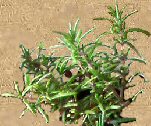 Rosemary Rosmarino Rosmarinus officinalis L. - Said to improve memory, often used for Alzheimer's. An antioxidant mint, a delicious preservative in lamb & chicken dishes, and a fragrant body wash. Rosemary herb enjoys a well-deserved reputation as a preservative. It is antimicrobial, antifungal, and highly effective against staph, e. coli, and psuedomonas. (Opdyke DLJ. Rosemary oil. Food Cosmet Toxicol 1974; 12: 977-8)
Rosemary Rosmarino Rosmarinus officinalis L. - Said to improve memory, often used for Alzheimer's. An antioxidant mint, a delicious preservative in lamb & chicken dishes, and a fragrant body wash. Rosemary herb enjoys a well-deserved reputation as a preservative. It is antimicrobial, antifungal, and highly effective against staph, e. coli, and psuedomonas. (Opdyke DLJ. Rosemary oil. Food Cosmet Toxicol 1974; 12: 977-8)
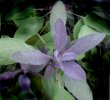 Sage Salvia Salvia officinalis L. - Antioxidant
Sage Salvia Salvia officinalis L. - Antioxidant
Stinging Nettles Ortica Urtica dioica L.- Tiny hairs/stingers applied to the skin ease arthritis pain. If you "accidentally" encounter this plant, common plantain or burdock leaves will ease your skin. Dried stinging nettles in capsules or as a tea. Highly effective for allergies, especially allergy to animal hair and dander, also supports the liver and kidneys.
Strawberry Fragola Fragaria vesca L. - Leaf tea used to reduce cramps, high in vitamins.
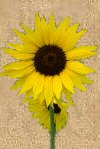 Sunflower Girasole Helianthus annuus & Helianthus tuberosus - Girasole (H. tuberosus) or Jerusalem Artichoke differ from sunflowers in that they produce no seed. The tubers are a great slowly digested starch for diabetics. Root can be eaten raw - sliced up, or cooked like a potato.
Sunflower Girasole Helianthus annuus & Helianthus tuberosus - Girasole (H. tuberosus) or Jerusalem Artichoke differ from sunflowers in that they produce no seed. The tubers are a great slowly digested starch for diabetics. Root can be eaten raw - sliced up, or cooked like a potato.
Tarragon Dragoncello Artemisia dracunculus L.
 Thyme Timo Thymus vulgaris L. - Aromatic and used in baths to relieve muscle pain. Tea soothes inflamed sinus. Anti-aging.
Thyme Timo Thymus vulgaris L. - Aromatic and used in baths to relieve muscle pain. Tea soothes inflamed sinus. Anti-aging.
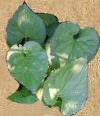 Violet Viola mammola Viola odorata L. - An edible plant (both flowers and leaves) that strengthens the blood vessel walls. Have seen violet leaf tea used effectively on bypass patients who have had the veins stripped from their legs providing relief from leg pain and faster vascular regrowth.
Violet Viola mammola Viola odorata L. - An edible plant (both flowers and leaves) that strengthens the blood vessel walls. Have seen violet leaf tea used effectively on bypass patients who have had the veins stripped from their legs providing relief from leg pain and faster vascular regrowth.
Watercress Crescione Nasturtium officinale R. Br. - Found in wet places, the mustard flavored leaves are packed with Vitamins A & C.
 White Clover Trifoglio bianco or Trifoglio ladino Trifolium repens
White Clover Trifoglio bianco or Trifoglio ladino Trifolium repens
![]()





Herbal Links
Italian English Perennial Plant Names Curarsi con le Erbe Terra di Toscana
Fiori di Montagna Virtual Italia & Foraging Italian Style Le Piante Alimurgiche Prodotti di Dryades
Commission E Monographs
Dr. James Duke Dr Andrew Weil Michael Moore John Robbins
Henriette's Herbal Homepage
Herbalgram
The Alternative Healing Guide from Answers.com
HerbMed
A Haven
Colleen's Garden Herbal anecdotes Essiac Tea Rosemary Gladstar Killer Plants Floriography
Songbirds, Truffles, and Wolves: An American Naturalist in Italy
by Gary Paul Nabhan - ethnobotanist. Amongst a host of other things Italian, he provides information about the pellagra epidemic. Pellagra is a nutritional condition caused by utilizing corn as a staple food without first treating it with lye or powdered limestone to release the niacin.
It should come as no surprise that as a child, one of my favorite books was the rare volume that my father owned - the Dept. of the Army "Survival Manual". Italian-Americans come from a strong foraging tradition & learn to respect the value of living things at a tender age. Many families have a gifted Nonna or someone like dear Zio Petrus - famous for plant knowledge, wine-making, and art skills. Thankfully, they often pass some of these gifts on to the next generation.
I grew up well outside of Chicago, adjacent to a small prairie, a swamp, and a heavily forested area. I and my brothers were rarely seen inside our home unless we were reading, doing artwork, or completing homework. Children were expected to be out of doors daily... participating in sports, horseback riding, swimming, skiing, ice skating, climbing trees and exploring the natural environment. Growing up female, in the USA, in the 1960's, meant I was excluded from most organized sports. My father was one of the Downers Grove Little League and Pony League Coaches (why yes, he also coached the Poffo boys). Every summer (and whenever) he and my brothers were involved in their baseball, football, or hockey games I was on the loose in Denburn woods.
Next to my childhood home were several old stands of wild onions, raspberries, chokecherries, and other edibles. I enjoyed all of them. Two older Chippewa-Cree / French-Canadian ladies, our (very patient) neighbors, spent a bit of time educating me about the local flora and fauna when they weren't making lace. My interest never waned. Later I co-sponsored a diabetes workshop with the Minneapolis Indian Health Center highlighting the importance of using Native foods to control the epidemic of Type II diabetes in modern communities. Our guest speaker was Mr. Angelo Joaquin of Native Seeds/SEARCH - my favorite seed bank in Tucson. They also have great healthy gift baskets by the way... I have also passed on some of my love of plants to the youngsters in the Lac du Flambeau summer school program and held workshops throughout the region on Diabetes Prevention using ancient recipes and exercise patterns. Today, I am in the process of restoring my new home's yard to include many of my favorite childhood plants.
copyright ? 2003 Laura Lancione - all rights reserved
 LAURA's
LAURA's 